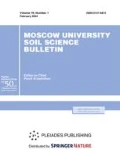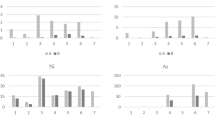Abstract
A laboratory study of the solid phase of saline peats by X-ray fluorescence (XRF) analysis has revealed the presence of organic halogen compounds. Cl-organic compounds were found in one-third of peat samples; however, their proportion was low: 14–15% of the total chlorine content. In contrast, Br-organic compounds are formed more often and the Brorg proportion is higher (from 12 to 23% of total Br). The relatively weak development of the halogenation of organic matter in the saline peatlands is explained by recovery conditions that prevent the synthesis of organic halogen compounds. An X-ray diffraction analysis (XRD) of the ash of saline peatlands has revealed four main minerals: halite, quartz, calcite, and gypsum. Halite absolutely prevails in low-ash peatlands. The XRD confirms the salinity of peatlands and gives the quantitative content of three minerals: halite, quartz, and calcite. However, analysis of peat ash may involve errors both due to the growth of minerals (gypsum) and due to the incomplete identification of the number of phases in high-ash peat samples. The second type of error can be corrected using data on the chlorine content in peat ash by X-ray fluorescence analysis. In addition to the construction of profiles of salt distribution in solution, it is necessary to determine the amount and composition of organic halogen compounds (some of them have herbicide properties) for characterizing the contamination of peatlands.
Similar content being viewed by others
REFERENCES
Vodyanitskii, Yu.N., Avetov, N.A., Savichev, A.T., et al., Influence of oil and stratal water contamination on the ash composition of oligotrophic peat soils in the oil-production area (the Ob’ Region), Eurasian Soil Sci., 2013, vol. 46, no. 10, pp. 1032–1042.
Vodyanitskii, Yu.N., Avetov, N.A., Savichev, A.T., et al., Chemical elements content in bog soils salted by drilling wastewater at oil extraction field in Middle Ob River Region, Agrokhimiya, 2013, no. 1.
Vodyanitskii, Yu.N. and Makarov, M.I., Humid soil samples change after their extraction from the cut, Agrokhimiya, 2016, no. 9.
Vodyanitskii, Yu.N. and Makarov, M.I., Organochlorine compounds and the biogeochemical cycle of chlorine in soils: a review, Eurasian Soil Sci., 2017, vol. 50, no. 9, pp. 1025–1033.
Vodyanitskii, Yu.N. and Mineev, V.G., Difference in the pH values of hydromorphic soils in field and laboratory analyses, Moscow Univ. Soil Sci. Bull., 2016, vol. 71, no. 1, pp. 1–7.
Vodyanitskii, Yu.N. and Savichev, A.T., The way to estimate elements content in soil under detection limit. By the example of X-ray fluorescence analysis, Agrokhimiya, 2017, no. 1.
Grinberg, I.I., Organicheskaya khimiya (Organic Chemistry), Moscow, 2001.
Makarov, M.I., Mulyakova, O.S., Malysheva, T.I., and Menyailo, O.V., Influence of drying of the samples on the transformation of nitrogen and carbon compounds in mountain-meadow alpine soils, Eurasian Soil Sci., 2013, vol. 46, no. 7, pp. 778–788.
Perel’man, A.I. and Kasimov, N.S., Geokhimiya landshafta (Landscape Geochemistry), Moscow, 1999.
Solntseva, N.P., Dobycha nefti i geokhimiya prirodnykh landshaftov (Oil Extraction and Natural Landscape Geochemistry), Moscow, 1998.
Biester, H., Keppler, F., Putschew, A., et al., Halogenretention, organohalogen and the role of organic matter decomposition on halogen enrichment in two Chilean peatbogs, Environ. Sci. Technol., 2004, vol. 38, no. 7, pp. 1984–1991.
Johansson, E., Krantz-Rulcker, C., Zhang, B.X., and Oberg, G., Chlorination and biodegradation of lignin, Soil Biol. Biochem., 2000, vol. 32, no. 7, pp. 1029–1032.
Kabata-Pendias, A., Trace Elements in Soils and Plants, Boca Raton: CRC Press, 2011.
Kotte, K., Low, F., Huber, S.G., et al., Organohalogen emissions from saline environments – spatial extrapolation using remote sensing as most promising tool, Biogeoscience, 2012, vol. 9, no. 3, pp. 1225–1235.
Leri, A. and Myneni, S.C.B., Natural organobromine in terrestrial ecosystems, Geochim. Cosmochim. Acta, 2012, vol. 77, pp. 1–10.
Oberg, G., Johansen, C., and Gron, C., Organic halogens in spruce forest through fall, Chemosphere, 1998, vol. 36, no. 8, pp. 1689–1701.
Oberg, G., Nordlund, E., and Berg, B., In situ formation of organically bound halogens during decomposition of Norway spruce needles: effects of fertilization, Can. J. For. Res., 1996, vol. 26, no. 6, pp. 1040–1048.
Oberg, G. and Sanden, P., Retention of chloride in soil and cycling of organic matter-bond chlorine, Hydrol. Process., 2005, vol. 19, no. 11, pp. 2123–2136.
Svensson, T., Sanden, P., Bastviken, D., and Oberg, G., Chlorine transport in a small catchment in southeast Sweden during two years, Biogeochemistry, 2007, vol. 82, pp. 181–199.
Vodyanitskii, Yu., Minkina, T., and Zamulina, I., Methodological aspects in the analysis of the content of mobile compounds of heavy metals in hydromorphic soils, Appl. Geochem., 2020, vol. 113, p. 104493.
Winterton, N., Chlorine: the only green element – towards a wider acceptance of its role in natural cycles, Green Chem., 2000, vol. 2, no. 5.
Funding
This study was supported by state budget topic “Land Use and Soil Mapping Based on Geographic Information Systems,” no. 115122210043.
Author information
Authors and Affiliations
Corresponding authors
Ethics declarations
Conflict of interests. The authors declare that they have no conflicts of interest.Statement on the welfare of humans or animals. This article does not contain any studies involving animals performed by any of the authors.
Additional information
Translated by D. Zabolotny
About this article
Cite this article
Vodyanitskii, Y.N., Avetov, N.A., Savichev, A.T. et al. Laboratory Determination of the Solid Phase Composition of Technogenically Salinized Peatlands: Possibilities and Limitations. Moscow Univ. Soil Sci. Bull. 75, 131–137 (2020). https://doi.org/10.3103/S0147687420030072
Received:
Revised:
Accepted:
Published:
Issue Date:
DOI: https://doi.org/10.3103/S0147687420030072




